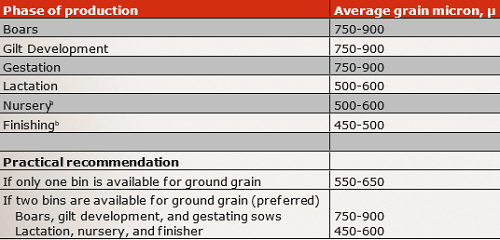



Grain Particle Size for PIC Pigs
GLOBAL - Particle size, depending on the phase of production, can be managed to maximise nutrient digestibility or to maximise longevity. Research has shown that for every 100 micron reduction in grain particle size, feed efficiency improves 1.0 to 1.2 per cent.Research has shown that for every 100 micron reduction in grain particle size feed efficiency improves 1.0 to 1.2 per cent(1).
Practical particle size recommendations are generally coarser for boars, gilt development, and gestation and finer for lactation, nursery, and finishing.
Grain particle size is influenced by testing methodology. Thus, consistency is key for successful particle size management.
Boars, gilt development, and gestation
A primary focus for boars, gilt development, and gestation is to maximise longevity while achieving good nutrient digestibility. A reduced particle size can increase the incidence of stomach ulcers(1) and potentially mortality(2). Therefore, based on the combination of these factors it is important to follow the acceptable range of grain particle size presented in Table 1.
Table 1. Grain particle size for PIC pigs

aIf flow agent is used, the optimum range will be reduced by approximately 50 microns.
bIf diets are pelleted, grain micron can be below 500 microns for nursery and finishing pigs to improve pellet quality.
Lactation
The focus of grain particle size for lactating sows is to maximise nutrient digestibility and, thus, milk output. Therefore, particle size should range from 500 to 600 microns on average. For every 100 micron reduction from 1200 to 400 microns, litter weight gain increased 1.3 per cent(3).
Nursery
Typically, the grain particle size recommended for the nursery phase is 500 to 600 microns for mash diets and, approximately, 400 microns for pelleted diets.
Grain particle sizes in meal diets greater than 600 microns will reduce the digestibility of nutrients and grain particle sizes smaller than 500 microns will decrease feed intake(4). The response to reducing particle size is similar for corn, sorghum, and wheat(4).
Finishing
Finishing is the phase of production where nutrient digestibility needs to be maximised the most. Most feed mills will grind grain as fine as possible as long as feed can still flow in bins, feed lines, and feeders. Pelleting diets reduces feed flow ability problems.
Woodworth et al.(4) reviewed the literature and concluded that there is little benefit to reduce below 600 microns in high quality pelleted diets; however, lower particle size often is used to improve pellet quality.
Particle size and ground grain storage capability
As shown in Table 1, if the feed mill only has one bin for ground grain, a compromise between all phases would be 550 to 650 microns; however, it must be noted that feeding gestating sows with fine grain particle size can negatively impact sow mortality.
Thus, two ground grain bins are recommended. Another approach is to limit the ground corn inclusion in the gestation diet by using other ingredients, such as DDGS that mitigate some of the negative effects of finely ground grain.
If the feed mill has two storage bins for ground grain, one bin could store grain at 450 to 600 microns for lactation, nursery, and finisher and the other at 750 to 900 microns for boars, gilt development, and gestating sows.
Evaluating particle size
For details about particle size testing methodology (time and whether to use an agitator or flow agent) please refer to Steinhart(5) and to Benz and Goodband(6). For current methodology on particle size evaluation please visit asi.k-state.edu.
Acknowledgements
A special thank you goes to Dr Mike Tokach for reviewing this document.
References
- Steinhart, T. 2011a. Swine feed efficiency: influence of particle size. Accessed on February 3rd, at http://www.swinefeedefficiency.com/factsheets/IPIC25d per cent20SFE per cent20Influence per cent20of per cent20Particle per cent20 Size.pdf.
- Goodband, R., Tokach, M., and Nelssen, J. 2002. The Effects of Diet Particle Size on Animal Performance, Kansas State University. p. 6.
- Wondra, K. J., Hancock, J. D., Kennedy, G. A., Hines, R. H., and Behnke, K. C. 1995. Reducing particle size of corn in lactation diets from 1,200 to 400 micrometers improves sow and litter performance. J. Anim. Sci. 73:421-426.
- Woodworth, J. C., S. S. Dritz, R. D. Goodband, M. D. Tokach, J. M. DeRouchey, C. R. Stark, and C.K. Jones. 2015. Optimal particle size for grain and other ingredients: What the research is telling us. Accessed on February 5th, at http://www.swinefeedefficiency.com/icfes.html.
- Steinhart, T. 2011b. Swine feed efficiency: particle size testing methodology. Accessed on February 3rd, at http://www.swinefeedefficiency.com/factsheets/IPIC25d per cent20SFE per cent20Influence per cent20of per cent20 Particle per cent20Size.pdf.
- Benz and Goodband, 2015. Three-sieve particle size analysis procedures. Accessed on February 3rd, at http://www.asi.k-state.edu/species/swine/research-and-extension/particle-size-information.html








